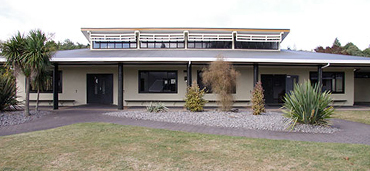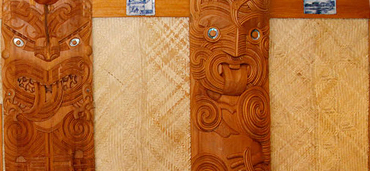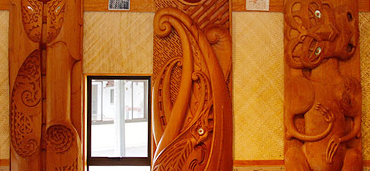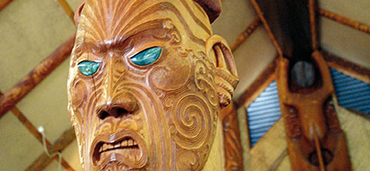Tangatarua Marae
Mokoia Campus is fortunate to have a marae on campus. Named Tangatarua, which translates to "two peoples, together in one place in one land."
Tangatarua Marae was officially opened on October 5, 1996 and is named after a Tūhourangi ancestor, Tangatarua, who lived on the land where Mokoia Campus is situated today.
Pepeha
Ko Tihi-o-Tonga te keokeonga
Ko Utuhina te awa
Ko Te Arawa te waka
Ko Ngati Whakaue te iwi
Ko Ngati Taeotu me Ngati Wahiao nga hapu Ko lhenga te whare tupuna
Ko Hinetekakara te tupuna wahine
Ko Te Papa o te lwingaro te whenua
Ko Tangatarua te marae
Buildings
The term marae is generally used to refer to the whole complex, including the buildings and the open space.
Tangatarua Wharenui - Ihenga
While a meeting house is considered sacred, it is not a church or house of worship, but religious rituals may take place in front of or inside a meeting house. The meeting or ancestral house both represents and depicts the ancestor of the hapū or tribe, and is named after an illustrious tupuna (ancestor). The Wharenui is named after the great Te Arawa explorer Ihenga, who is the one who named a few of the lakes in the Rotorua area.
It is customary to remove one’s shoes when entering the wharenui however, there are some iwi that allow men to leave their shoes on. To avoid any inappropriate actions, it would be wise to remove your shoes before entering any wharenui.
Marae Dining Room - Hinetekakara 
This is the dining room, the place where the "inner being" is satisfied. As this is a place for eating no one must sit on any table or pass food over a persons head. There is also no smoking in the wharekai.
Kawa/Rules and Tikanga/Customs
The kawa and tikanga pertaining to Tangatarua Marae are in accordance with Te Arawa protocol. The kawa for Tangatarua is Tauutuutu. This means that the karanga and the whaikōrero are performed using a similar procedure.
Inside the Wharenui
Only medication and water are permitted to be consumed while inside the wharenui. No other food is permitted. No clothing to be displayed or attached to the whakairo (carvings) around the walls. Do not sit on tables or pillows.
Pōhiri Process
Although formal, a good pōhiri is a warm and enjoyable experience. Find out what to expect on our Pōhiri at Toi Ohomai page.
Whāriki/Mats 
Tangatarua flax work was created by Master Weaver Tina Wirihana. The weavings within Ihenga join everything together. The main two themes were the whāriki and kete (kit) using the harakeke plant, and the pingāo (tussock) plant. Tina likened the fibre used in Ihenga to the tōtara timber which is also fibre.
Whakairo/Carvings
These represent a part of history and encompass three main kaupapa (ideas) - record of history and events, identity and decoration. Whakairo in Tangatarua were created by Master Carver Lyonel Grant. The carved Pou Tiaki (ancestors) throughout Ihenga represent not only ancestors of the Māori, but also those of Polynesian and European ancestors.
Marae Ihenga Carving
The tekoteko (carved figurehead at the apex of the wharenui) is the great, great, grandfather of Ihenga, Atuamatua. The kōruru (figurehead below Atuamatua) is Ihenga. The poukaiariki [figurehead at the base of the poukaiāwha (centrepole in the mahau or porch)] is Tūmatauenga. The amo taha matau (the carved pou on the right of Ihenga) is his father, Tūhoromatakakā. The amo taha maui (the carved pou on the left of Ihenga) is his uncle, Kahumatamomoe.
Marae Back Wall
The rear wall represents Te Ao Tawhito (the ancient world of the Māori, where the knowledge base is), and is called “Te Wāo Tapu Nui a Tāne-mahuta” (the sacred forest of Tāne-mahuta). Ancestors and gods representing Polynesia are featured within the sacred forest. The huge centre Pou represents the whakapapa pertaining to the Te Arawa tribe. The figurehead at the apex is Pūhaorangi (a spiritual being who lived amongst the heavens). The base of the centre Pou is Te Kuraimonoa who descended from the earth mother Papatuānuku. Pūhaorangi and Te Kuraimonoa had a son called Ohomairangi (the figurehead in between). From Ohomairangi the descent begins, generation to generation to Te Arawa living on the land today.
Marae Front Wall
The front wall represents Te Ao Hurihuri (the world of today). The high structures represent the skyscrapers of our large cities. The blue design represents the face of Māori looking at the world they are living in today. The figurehead at the apex, is Kupe, below him is Ngāhue, below Ngāhue is the of wife Kupe, Hineteaparangi, and the base is Muturangi the octopus.
Marae Left Wall 
Inside the tupuna whare, Te Pou Hurirōpa a Houmaitawhiti (the left corner of Ihenga from the doorway), we have Tūhoe Pōtiki. In sequence from this corner to the rear wall we have, Tamakihikurangi, Toroa, Hoturoa, Turiā Nui, Ruātea and Maungaroa, Whata and Manāia, Kāpene Kuki (Captain Cook), Pawa, Ruanui, Rongomai, Tura, Tangatawhenua Tūturu and Te Hau Wāhine.
Marae Porch Wall
The Pou Tiaki in the mahau are “Ngā Waru Pūmanawa o Te Arawa” (the eight children of Rangitihi). Each pou tiaki of the eight children are named. The pare (lintel above the doorway) represents the ira wahine (female ancestors). They are Kearoa, Motuōtaku, and Whakaotirangi. The lintel above the window represents the four wives of Rangitihi, they being Rongomaiturihuia, Kahukare, Papawharanui and Manawakotokoto.
Marae Right Wall
Te Pou Hurirōpa a Whakataupōtiki (the right corner of Ihenga from the doorway) we have Whakaue Kaipapa. In sequence from this corner to the rear wall we have, Maaka and Tahu Matua, Tia and Hei, Ngātoroirangi, Kuiwai and Haungaroa, Ruāeo, Tamateaārikinui, Tahimana (Abel Tasman’s ship the Heemskerck), Paikea, Nukutawhiti, Whātonga, Araiteuru, Huiterangiora and Te Hau Tane.
Marae Poutokomanawa 
The Poutokomanawa (centre pole) is the heart of Ihenga. The figurehead at the base is Tangaroa (the god of carving, also god of the sea).
Marae Backbone
The Tāhūhūroa o te Tupuna Whare (the backbone at the apex of the tupuna whare) is not only the Te Arawa canoe, but also Te Waka o Te Mātauranga (the canoe of education). The canoe represents the rowing of knowledge from the ancient world through to the world we are living in today. The front of the canoe is situated in the mahau, and is taking all that knowledge on, for our tamariki and mokopuna (children and grandchildren) of future generations
